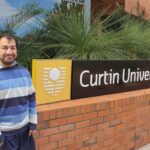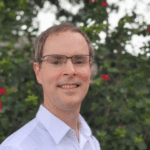We were sorry to hear that WA Institute of Technology (WAIT) graduate Paul Dench, a space engineer who tracked the first NASA shot to the moon, passed away on 26 June at 86 years old. Paul first enrolled at WAIT in 1975.
Paul began his career journey at the British Meteorological Office as a metrological observer, studying cloud precipitation and attaching weather sensors to 100-metre towers during storms. In 1963, he and his family travelled to Australia after Paul was offered a job with Australian Wireless Australasia. He later moved to Carnarvon and went on to become telemetry engineer of the yet-to-be-built Carnarvon Tracking Station.
Paul helped transform the sandy ridge into a functioning tracking station – the biggest NASA space tracking station outside of mainland America. Once it was built, NASA would send personnel who were familiar with astronaut tasks to Carnarvon to act as voice communicators between Carnarvon and manned Gemini spacecraft, whose mission was to enhance the US’s space travel capabilities. Paul’s son, Alan Dench, who is currently Provost at Curtin University, remembers growing up in Carnarvon with the occasional astronaut coming to dinner. In 1968, Paul was appointed Chief Engineer of the Carnarvon Tracking Station and in 1970 became Company Manager.
When NASA commenced its Apollo program sending men to the moon, Carnarvon played a critical role. Paul had some wonderful memories at the station, watching the lunar lander probe appear pixel-by-pixel, a transmission of close-up views of the moon’s surface and seeing Neil Armstrong stepping on the moon for the first time. In a later interview he explained, “Space had got in my blood, it’s still in my blood and I still maintain an avid interest in it.”
Paul supervised many of the command tasks during the missions, with Apollo 13, the third planned attempt to land men on the moon, which later had to be aborted due to spacecraft failure, being among the most memorable. The Carnarvon station issued the ‘go’ signal that sent the Apollo craft’s final rocket stage to blast out of the Earth’s orbit, and was the only station able to track the returning crew during re-entry after they decided to return to Earth.
“For most of the final three hours or so of the journey back to Earth, Carnarvon was the only station in contact with the astronauts,” Paul Dench said.
An active member of the Carnarvon community, Paul advocated successfully for a senior high school in the town, he become a Justice of the Peace and in that role often served as acting magistrate. In 1975, NASA closed many of its ground-based tracking stations including Carnarvon, so Paul began a new chapter in his career.
Paul and his family moved to Perth in 1975. He studied at WAIT – the predecessor institution to Curtin University – and achieved a Graduate Diploma in Education (Secondary) that year, then a Graduate Diploma in Administration in 1977, and Master of Education in 1983. Paul studied full-time and worked evenings as a security guard to support his family through 1975. When Paul graduated in 1976 he was the first person in his extended family to graduate from university.
Going on to teach in government schools, Paul became a project leader at the Department of Education focusing on the use of computers in schools. Paul was also a primary school teacher, working at Melville PEAC and later at Scotch College. He was elected as the first computer educator of the year in 1995 by the Educational Computing Association of Western Australia (ECAWA). During Paul’s time at the Department of Education, he ran a small Language Controlled Software project from 1988, and one of the projects, Yintarrie Bilingual Literacy Project (Coonana WA) won an International Literacy Year Community Project Award in 1990.
Once Paul had retired, he co-authored a book with Alison Gregg called Carnarvon and Apollo: One Giant Leap for a Small Australian Town, published in 2010.
As an engineer, teacher, active member of the community and quiet achiever, Paul made an incredible contribution to the lives of others:
“I first met Paul Dench through the ECAWA, during my time as a Sessional Lecturer at the School of Education. I was so excited about the potential of enhancing learning through technology of which Paul was such a strong advocate. I was such a novice in those days and was amazed with the ease that he shared his expertise and experience. It was years later that I found out about his previous life as an Engineer in Carnarvon, and felt even more privileged to have been involved with ECAWA during his time there. Paul was a real exemplar of a lifelong educator.” – Professor Lina Pelliccione, Pro Vice-Chancellor and President, Curtin Mauritius
“Paul was a very active participant in the Science Teachers Association of WA and a great promoter of primary science and environmental education. It was always a pleasure to have discussions with him about our mutual interests in enhancing learning opportunities in science for young students.” – John Curtin Distinguished Professor David Treagust, School of Education, Curtin University
Paul is survived by his wife Joan, his five children Alan, Alison, Phil, Jo and David, six grandchildren and one great-granddaughter.



